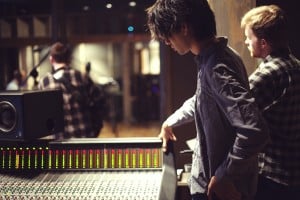One fundamental question we get asked frequently in the studio is whether to record a band live or to record each instrument separately. Tracking one instrument at a time allows for perfect isolation and the ability to focus everyone’s attention on getting that part recorded perfectly. So why not build every song this way? Why not have the drummer play to a click track, then lay each instrument over that separately until you’re done? Well, hang on – we kinda do that in the studio, but not exactly. We strongly recommend in a typical band situation (drums, bass, guitar, keys and vocals), that the rhythm section record live together – including a scratch vocal take from the singer. We do it this way because bands are used to performing together and we aim to capture great performances.
 Share a Room
Share a Room
Here at Night Train Studios, even though we have four iso rooms, we have learned that it often works best to have the drummer and bassist share the same room. These two are the rhythmic core of the band and even though they are wearing headphones with individual mixes, bassists often perform better when they can also “feel” the drums during a take. If the drummer is able to play to a click (and in our experience, very few are) we can feed a click track into just his/her headphone mix, which will help keep the band in time and makes for cleaner overdubbing later on.
In other iso rooms we’ll setup the guitarist and keyboardist with their own headphone mixes and good sightlines to the bass/drum room. If everything goes well, after a take or two we’ll have captured all the rhythm instruments performing live together. After everyone comes back into the control room and we pick the “keeper” take, we can then fix any mistakes. Flubbed bass, guitar or keyboard notes are relatively easy to fix. Once identified, the musician goes back into the iso room and before any mics have been moved or amp settings changed, they play along to the section with the mistake and overdub the corrected part.
Fix the Sticks
Fixing drums is a different story. They are the backbone of the song and because any flubs are picked up by multiple microphones, it is very difficult and time consuming to fix the performance digitally. If the drummer hasn’t “nailed it” after about two or three takes, we worry about the performance becoming stale, so if we have identified isolated drum/timing mistakes, we typically have three options: 1) Do another take from the top (but now the drummer is extra nervous and more likely to be tense) 2) If it was a flubbed drum roll or transition, the drummer can overdub that part only or 3) Have the band go back in and record starting from the flubbed part until the end of the song.
It is very important to fix any drum mistakes before moving on to your other overdubs. Any awkwardness in the rhythm of a track can throw off your other overdubs later, and you don’t want to end up spending entire subsequent sessions working on past drum mistakes (we speak from experience here!).
Overdubs: Horn Sections
Once we have captured a great rhythm performance, we now have what is analogous to a well-built building foundation – solid, well designed, square and plumb. From here we can focus on individual performances – layered rhythm guitar overdubs, guitar solos, lead vocals, backing vocals, horns, percussion, etc. That said, there are still times when capturing more than one performance simultaneously is the way to go. For instance, horn sections, vocal harmonies and string arrangements fit into this category.
While it is easy enough to record these instruments individually, these performers are accustomed to playing with one another and you can get some strange results if you don’t do it together. Take a typical horn section; say tenor sax, trumpet and trombone. The simplest way to capture their overdub performance might be to set up the players in a room with two microphones in a stereo X-Y or mid-side configuration and hit record. But what if the trumpet is too loud? You can try moving the trumpet player back further, but this usually causes more problems than it solves.
At this point you could ditch the stereo mics and individually mic each player. But what if the sax player is a bit sloppy on his timing? We’ll usually go to Plan B at this point. Putting each player in a separate room with their own mics gives you the best of both worlds – isolation so you can fix things later and adjust levels independently – with the benefit of everyone hearing what they’re used to hearing while playing live.
ABOUT THE AUTHORS
Zac Cataldo is a musician and owner/producer at Night Train Studios, a recording studio in Westford, MA. He is also co-owner of Black Cloud Productions, a music publishing company. Reach him at [email protected].
Brent Godin is a bassist/guitarist and engineer/producer at Night Train Studios. He is also a talent scout at Black Cloud Productions. Reach him at [email protected].
photo by Jen Painter
